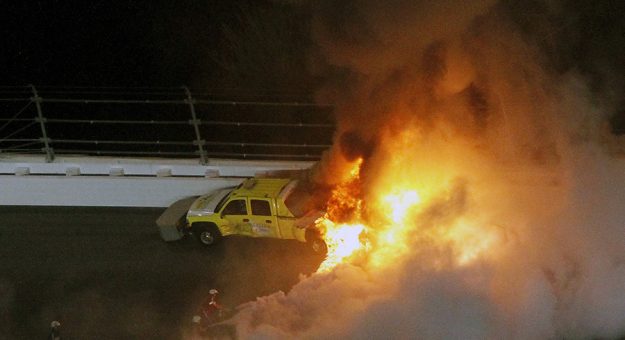Through NASCAR’s 73-year history, many strange and bizarre occurrences have made headlines. Here’s a look back at some of those incredible stories:
Feb. 10, 1952 — Wooden Roll Bars
A total of 118 drivers started the 24-lap race for modified and sportsman cars on the 4.1-mile road/beach course in Daytona Beach, Fla.
Roll bars were required for every car entered. The Ford owned by J.B. Watkins and driven by Tim Flock didn’t have them. NASCAR founder Bill France was on the beach building fencing for restricted areas. France allowed Flock to run wooden 2-by-4 roll bars but told him if anyone protested, the rules (requiring metal roll bars) would stand.
Flock won the race but second-place Jack Smith protested the unusual rollbars and Smith was awarded the victory.
A statement issued from NASCAR after the race read in part: “Flock was notified before the race that if he finished in the money, he would be subjected to protest. However, the young Atlantan elected to start the race without altering the roll bars in his car. Flock was disqualified entirely and received no money whatsoever.”
Flock won the NASCAR Cup Series title that season and again in 1955.
Feb. 13, 1960 — NASCAR’s Largest Crash
During a modified/sportsman event at Daytona Int’l Speedway, 68 drivers took the green flag with polesitter Banjo Matthews leading the first lap over Fireball Roberts.
A second group of cars some 500 yards behind them began crashing in the fourth turn with 37 cars involved. It stands as the largest melee in NASCAR history.
Twenty-four of the cars involved were too badly damaged to continue. Drivers received some broken bones, minor cuts and bruises, but no serious injuries were reported.
Only 26 of the 68 cars finished the 250-mile event that was won by 38-year-old lunchroom operator Marion Farr.
Aug. 12, 1973 — A Strange Race at Talladega
The 1973 Talladega 500 is remembered as the most bizarre event in the 52-year history of Talladega (Ala.) Superspeedway.
Team owner Jimmy Crawford, a pilot for Eastern Airlines, bought a 1972 Plymouth and planned to race it without any driving experience. However, a deal was worked out with veteran driver Dick Brooks to drive the car. After overheating problems, a pit road collision and falling two laps down, Brooks came from 24th starting position to win the race.
Larry Smith, NASCAR’s 1972 rookie of the year, was killed in a single-car crash on lap 14. His crew chief, John Green, stated, “I couldn’t believe it. I already started working on the car. I thought we could get back in the race.”
Also, 1970 NASCAR Cup Series champion Bobby Isaac was leading the race in Bud Moore’s No. 15 Ford when he suddenly pulled into the pits and told Moore he quit. Clifton “Coo Coo” Marlin got in the car after falling out with engine problems in his own Chevrolet and finished 13th.
“I wasn’t afraid I was going to wreck,” Isaac later told reporters. “I don’t have anything to prove to myself or anyone else. I know how it feels to drive and I know how it feels to win and lose. I know how it feels to be a champion and now I know how it feels to quit.”
Isaac, the winner of 37 races, returned to the Cup Series for 19 starts through 1976. He died from a heart attack while racing at Hickory (N.C.) Motor Speedway on Aug. 14, 1977.
May 18-19, 1975 — A Helpful Friend
During the Mason-Dixon 500 at Dover (Del.) Int’l Speedway, Dick May drove five different race cars, including his own. May drove in relief of four drivers in a race that took two days to complete because of rain.
May’s Cup Series career of 185 starts lasted from 1967 through 1985. The New York native died in 2009.
Click below to continue reading.
